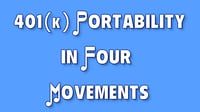By Thomas Hawkins | May 16, 2022
 Over the past 15 years, a very large (250,000+ participants) 401(k) plan sponsor that our company has had the opportunity to serve has been highly successful in delivering improved participant outcomes by incrementally adopting a full program of retirement savings portability.
Over the past 15 years, a very large (250,000+ participants) 401(k) plan sponsor that our company has had the opportunity to serve has been highly successful in delivering improved participant outcomes by incrementally adopting a full program of retirement savings portability.
Were the plan’s experience set to music, it could be described as “401(k) Portability in Four Movements” – opening with discordant levels of cashout leakage but quickly building towards more satisfying participant outcomes, including substantial improvements in the preservation and consolidation of retirement savings.
Movement #1: Rampant Cashout Leakage (2002-2006)
In the five years 2002-2006, prior to the implementation of portability initiatives, the plan experienced very high levels of cashout leakage, where 40% to 56% of terminated participants cashed out their savings in the year following separation.
While high, these cashout leakage levels are all too common for 401(k) plans, where system-wide cashout leakage averages 40%. For this plan sponsor, high annual employee turnover (approximately 25%), helped fuel an increased propensity to cash out.
The plan also had to deal with the costs and risks associated with increasing numbers of stranded, small-balance accounts, a high incidence of missing participants and a large volume of uncashed distribution checks.
Movement #2: Education & Assistance for Terminated Participants (2007-2011)
Our initial engagement with the plan sponsor began in 2007 and was focused on providing education & assistance for all terminated participants, which took two forms: 1) an assisted roll-out program and 2) an automatic rollover IRA program.
The plan’s assisted roll-out program applied to all terminated participants with balances greater than $5,000 and included outreach (mail and outbound calling) to help participants understand their options, avoid cashing out, and if desired, move their retirement savings to a new plan, an existing or new IRA or fixed annuity.
Applying to all terminated participants with balances less than $5,000, the automatic rollover IRA program included participant-friendly features such as accepting balances less than $1,000, performing electronic searches to obtain the latest participant address information, and providing participants with pre- and post-rollover assistance to discourage cashing out, while facilitating portability of plan balances.
In the years 2007-2011, the measurable impact of these two programs was impressive:
- Across all balance segments, cashout leakage plunged to 27.2%, from an average of 48.5% during 2002-2006
- For plan participants with balances less than $5,000, cashout leakage was more than halved, dropping from 56% to 26.5%
From the plan’s perspective, these programs – while improving participant outcomes – also addressed many of the underlying causes of small, stranded accounts, missing participants, and uncashed distribution checks.
Movement #3: Facilitated Roll-Ins for New Participants (2012-2016)
In 2011, with the introduction of a facilitated roll-in program, new and existing participants were added to the mix. Each new plan participant was notified about the roll-in program and offered plan-paid, expert assistance to consolidate their retirement savings from former-employer plans or from IRAs.
Underpinning the new roll-in service was an automated workflow process that tracked all forms, paperwork, signatures and funding required to effect consolidation, effectively isolating plan participants from the inherent complexity of the roll-in process that typically discourages participants from attempting to perform these on a “do-it-yourself” basis.
The facilitated roll-in program also produced measurable improvements in retirement outcomes:
- During the five-year period (2012-2016) that followed, roll-in transactions surged five-fold over previous levels, accounting for 16,031 facilitated roll-ins
- Participants who consolidated their retirement savings into the plan saved time and money – simplifying their retirement planning, while saving money on fees paid for multiple retirement savings accounts
Movement #4: Auto Portability Introduced (2017-Present)
In 2017, a consent-based form of auto portability was introduced for plan participants. All newly enrolled participants were included in an electronic matching algorithm to determine if they held a safe harbor IRA balance on our books. If matched, that participant was notified about the IRA balance and offered an automated transfer of the balance into their plan, given their consent.
By the end of the five-year period 2017-2021:
- Matches were found for 5% of all safe harbor IRAs
- Responses were obtained from 29% of those matches
- Automatic roll-ins were executed for 99% of responders, for a total of 2,701 roll-ins
Also, during this timeframe, other consolidation activity both into and out of the plan increased:
- Total consolidations (excluding automatic roll-ins) increased to 97,064 (vs. 83,641 during 2012-2016)
Finally, an ongoing focus on education and assistance drove further declines in cashout leakage:
- From 2017-2021, annual cashout leakage (all balances) decreased to an annual average of 22.8%.
- In 2021, as the country headed into The Great Resignation, cashout leakage declined to an all-time low, with 19.4% of terminating participants cashing out their balances.
The Impact of Retirement Savings Portability
The strongest case to be made for retirement savings portability is the measurable improvement that occurs in participant outcomes, and there’s no finer example of those outcomes than the multi-year, real-world experience of this plan sponsor, where thousands of participants increased their prospects for a timely and comfortable retirement.
It’s also clear that delivering more 401(k) portability would be music to the ears of participants. EBRI’s 2022 Retirement Confidence Survey found that almost 72% of the respondents preferred that their retirement savings be consolidated into an existing retirement savings account, against only 28% who preferred that their savings remain in their previous employer’s plan.
Back
 1916 Ayrsley Town Boulevard
1916 Ayrsley Town Boulevard